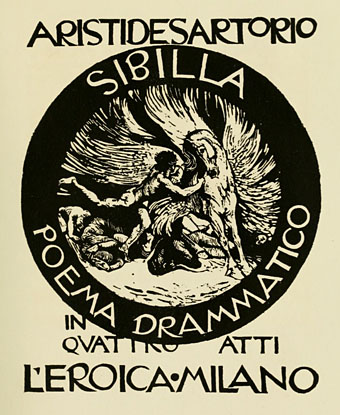
When the paintings of Giulio Aristide Sartorio were featured here a while back I wasn’t aware of Sibilla: poema drammatico in quattro atti, a book written and illustrated by the artist and published in a numbered edition of 1333 copies in 1922. Not content to merely write a lengthy dramatic poem then add some illustrations, Sartorio hand-crafted some 240 pages, text as well as illustrations, in what looks like woodcut printing but this page tells us was a style of relief etching which gives a woodcut appearance. At least half the book comprises full-page illustrations so it’s no surprise that Sartorio spent the best part of a decade working on it. The copy at the Internet Archive is one of the original printings, signed by the author/artist and his publisher, Ettore Cozzani. This page shows preliminary sketches for what has to be one of the final breaths of fin de siècle excess.
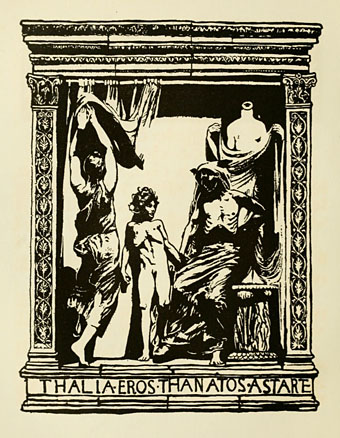
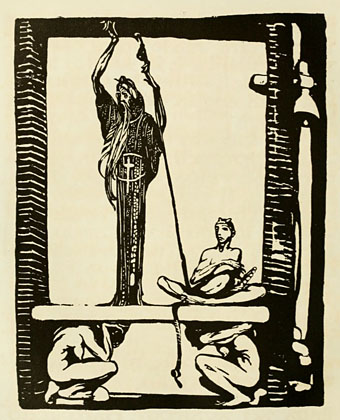
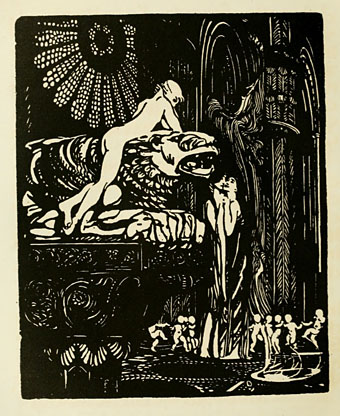
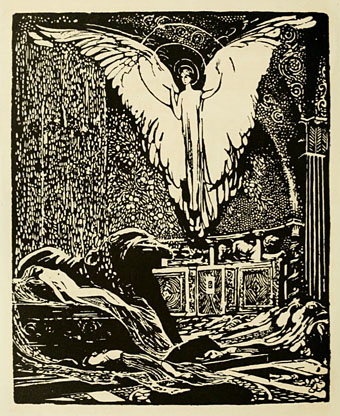
Elsewhere on { feuilleton }
• The illustrators archive
Previously on { feuilleton }
• Lussuria, Invidia, Superbia
• The art of Giulio Aristide Sartorio, 1860–1932

Oh, i’m italian, but i have to say it’s the first time i see such a wonderful italian book! Of course i had already heard of Aristide Sartorio, but i was completely unaware he wrote and illustrated this jewel-book, really. So, i have to thank you again, John, for this important discover for me. I will read this ‘poema drammatico’ with great pleasure.
Andrea
This post reminds me somewhat of your posts regarding symbolist/decadent influences upon Bram Stoker’s Dracula. Another mainstream director who, in my opinion, had the balls at one point to show some symbolist-like flair, how distant in the past this may be, was Ridly Scott when he directed ‘Legend.’ When I first bought that DVD years ago, I was initially distracted by the differences between the European director’s cut and the American version, but upon sitting and watching the entire thing, I was converted pretty well right then and there. The pacing and music is better for one, but the characters and the world are better explored and developed as well. The otherworldly, subterranean palace where Tim Curry’s satanic character resided was stunning, was utterly laden with strange aesthetic allure.
A few of these pictures, especially the third of the four consecutive ones under your text, really remind me of some the imagery in that movie.
I am looking through the PDF for Sartorio’s book, not all of the illustrations are quite so vivid and yet mysterious in their compositions, but they are all very nice to look at.
What is Fred Astaire doing with Thalia Eros and Thanatos? :-)
Wiley: Yes, Legend would have found favour with the Symbolists who followed Arnold Böcklin, many of whose paintings illustrate Teutonic myths. I think Fritz Lang’s Siegfried was inspired in part by Böcklin. I quibbled with some of the Legend storyline but Ridley Scott at his best flatters the eye like few other directors, Blade Runner being the other notable example. I haven’t seen Legend for some time, I ought to watch it again.
I’ve not heard of ‘Siegfried’ before, over the years I’ve found that many of Fritz Lang’s other notable works have all been overlooked in favor of just ‘M’. Still a good movie, but he ought to be known for far more than just that.